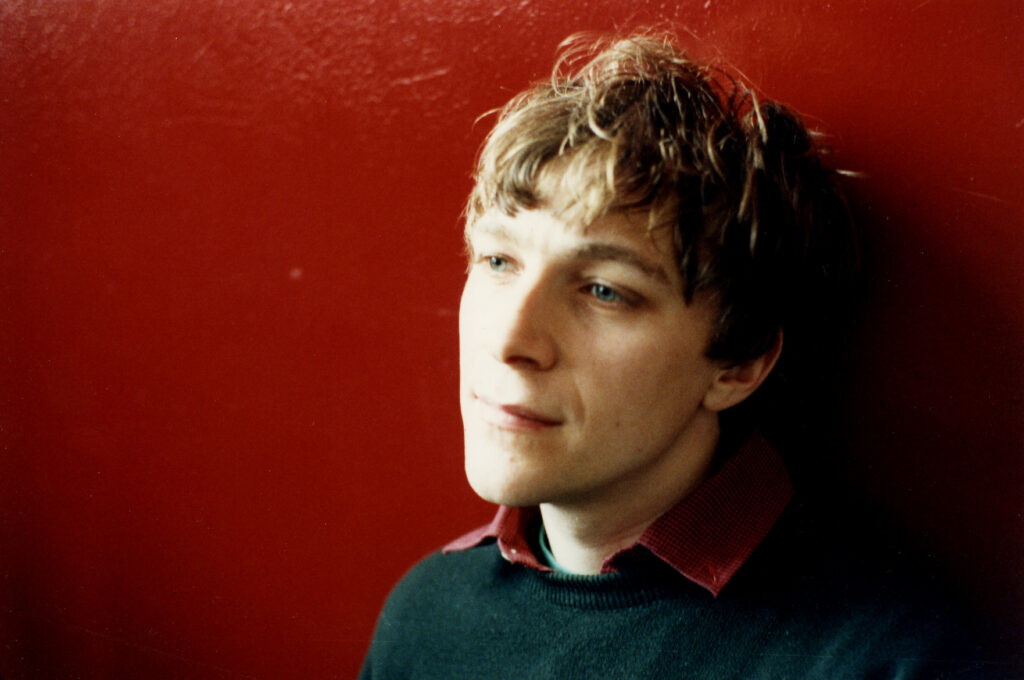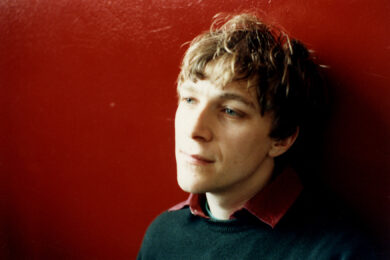More Everett action at Mr True’s Blog!
There’s an album out, Two Sunsets. It’s a collaboration on Geographic Music between Scotland’s Pastels and Japan’s Tenniscoats, full of warm, melancholy electronica and the odd, hushed Mary Chain cover. It’s very calming. It’s not brash at all. It’s welcome and intimate, like a lover’s wanted waking breath (obviously I’m talking initial impressions here; waking breath never smells so sweet the 5,000th time around). It makes the listener feel special just by listening. Think: cushions scattered on the floor; a piano with its entrails exposed but still cared for; the light gently flickering as one of Brion Gysin’s dream machines slows to a crawl; friends meeting and parting and knowing they’ll never truly be apart; the gentle trickle-down beneath a parachute.
“In the places we will be/Thoughts of you come back to me/Walk to you and walk with you/In the light between,” Stephen Pastel sings on the unashamedly beautiful, quietened ‘Song For A Friend’, being answered back by a trembling female voice and woodwind.
I first heard the album during a plane flight to Perth earlier this year just as the sun was setting across WA, all oranges and yellows with the odd trail of blue, dissolving into a clear white sky. Obviously, it was an appropriate setting.
The album has stayed with me, through many plays and friends and Brisbane’s unchanging weather.
I sent Stephen some questions centred round it.
1. How did you first encounter Tenniscoats? How did they first hear of The Pastels?
“When we first visited Japan in 1993 we felt to an extent unconnected from many things, like a ‘pop group abroad’. Everything was very scheduled and rigid, and it was difficult to escape from this so that we could explore for ourselves this friendly, alien place. We knew about the Cornelius /Trattoria / Shibuya-kei scene and heavier music like Keiji Haino / High Rise / PSF and then groups that played with us like Honey School Friends. But it was really hard for us to find the kinds of music that we would in other places. We played in Japan three times in the 1990s and on the final trip in 1998 I was given a Hallelujahs record (by Kenji from Rover Records) which I really got into, inevitably wondering if other great things were taking place.
“I don’t know how or where they first heard The Pastels but I know that when they joined Maher Shalal Hash Baz, Tori asked them what music they liked and they both said The Pastels.”
1.1 Who are The Hallelujahs?
“The Hallelujahs were a primitive, slightly naive sounding pop group with insane guitar solos courtesy by someone called Idiot O’Clock. The music was fragile and folk-psychedelic but I also thought I could hear a little bit of the TV Personalites or The Clean – really, really special. The leader Shinji Shibayama later became less obscure with his follow-on group, Nagisa Ni te.
“A few months later, David Keenan excitedly reviewed Maher Shalal Hash Baz’s Return Visit To Rock Mass in The Wire (on Org Records, The Hallelujahs’ label) and soon after Katrina and I were staying with him and he played us some of the songs, probably knowing that we’d love them. And actually it changed our lives because eventually we set up Geographic Music to release their records.”
1.1.1 Were Maher Shalal Hash Baz always the main band, or did you have others in mind? Please explain the ethos of Geographic a little.
“Maher gave the label an immediate identity and a sense of purpose, it was exactly the kind of music that we felt that Geographic should be about – hopeful music, original, unyielding, beautiful.
“Tori and Reiko Kudo from Maher were living in London, and Tori got in touch with David Keenan and we decided that we had to invite Maher to Glasgow to play. The day before the show I was DJing in a vaguely trendy club and I saw a young Japanese couple. That was Saya and Ueno, the Tenniscoats, and they were playing with Maher at the show.”
2. How did the idea of collaborating come about?
“Saya and Ueno were touring in Scotland as part of an event that Bill Wells had organised with Maher Shalal Hash Baz and other musicians. At the end of the tour, which Katrina had played drums on, they asked us if we’d like to go into the studio with them just to see what would happen. By then we really loved Tenniscoats music so it was an easy decision for us.”
3. Did you enter the studio with certain ideas for songs in mind? Please give a couple of examples of how songs gestated.
“Yes, we always had some kind of idea, no matter how vague, and some of the ideas were already very developed. The music wasn’t out of nothing / improvised – usually at least one or two people had something concrete and suggestions for the direction it should go in. ‘Song For A Friend’ was a really special collaboration because it was for Tenniscoats’ friend DJ Klock who had committed suicide in 2007. Saya and Ueno talked to us about him and asked us to write some words which immediately felt very trusting and intimate. I think we all felt that we were involved in making a record that was important for us all.”
4. Were you trying to capture a certain atmosphere?
“I think with every record you’re trying to capture a certain atmosphere, discover what the record is. I wasn’t quite sure what the atmosphere of Tenniscoats and Pastels music was until we finished but I think it’s one of friendship, trust, chance and maybe a certain melancholy in places.”
4.1 Why melancholy?
“I don’t know why everything we do sounds slightly melancholic, it’s just always there. I never want to be suffocating in this but in small amounts I think it’s an important part of music; we’re always moving on, maybe leaving something behind so I feel it’s important to document it.”
5. Do you see this record as a natural continuation from [previous Pastels’ album, 2003’s] The Last Great Wilderness, even though this isn’t a Pastels album per se?
“Some of the music started out as pieces we were working on for a theatre production by a Glasgow company called 12 Stars. They partly commissioned us on the basis of The Last Great Wilderness so we felt a certain obligation to continue from that, and actually we were happy to. We were more or less working on both projects at the same time and one day while Tenniscoats were waiting for us to finish up they heard the theatre music and asked if they could contribute to it. So the two projects became very blurred. And I think there are similarities in sound too.”
6. What or who are The Pastels these days?
“Well, we make group music in the way that we always did. I wouldn’t like to say how we fit into things but we’re not really the outsiders we were when we started. I hope our music’s still very recognisable but maybe not exactly the same as it was 20 years ago. I think our music’s always been defined by songs and by the people in the group. At the moment that’s me, Katrina, Gerard Love, Tom Crossley, Alison Mitchell, John Hogarty, and Norman Blake.”
6.1 How do you view groups these days? When you start, is it more of a gang? Now, is it a collective?
“I’ve always liked a group sound better than the genius of one. For me, The Beatles every time, rather than Paul McCartney layering up Paul on top of more Paul. I like the way people hear things slightly differently and the negotiation and the slightly different rhythms within a group and the complications and triumphs of the unexpected. Maybe some groups are gangs but that was never really The Pastels. When we play music it is in one way as a collective but usually the original idea will come from myself or Katrina, and I suppose we’re always trying to keep that idea which maybe we don’t even understand completely.”
7. Where did the title come from?
“Two Sunsets was the first song that Tenniscoats invited us to play on. It was the song that suggested we should make an album together. I think it always seemed like the most natural title for the album.”
8. What are the dissimilarities between The Pastels and Tenniscoats?
“Not so many. I think both groups have a very strong idea of what we’re about and I think we’re both very instinctive and tend to come to decisions quickly. I think we didn’t really clash in terms of our tastes which usually coincided. Maybe Tenniscoats are slightly more spontaneous and can come to their ideas quicker than The Pastels. I think we sometimes wait too long for the perfect opportunity.”
8.1 Could you expand on this a little more, please?
“I think we sometimes have had something and then thought it would be even better in a while. But in a while we had something else. After Illumination we were writing well and the group was sounding great with the addition of Tom, and Annabel was still playing bass with us. We recorded a Peel Session and it sounded so promising. It would have been good to record an album or even an EP then. Also, in the beginning it took us ages to make our first album and the record we made sounded to me completely unlike a first album.”
9. What is some of your favourite music to listen to these days?
“I’ve actually been playing The Smiths a lot which is a bit weird – at the time I wasn’t really a massive fan.”
9.1 What do you like about it now that you didn’t then?
“Finally, I think I got past the production and fell in love with the songs. Are you a fan?”
9.1.1 I never got past the production.
“But I most often play things like Tarwater, To Rococo Rot and maybe Brian Eno instrumentals. It’s music that you can do other things to while it’s playing – it creates a really good, interesting feeling but it doesn’t get completely in your face. This summer I’ve really liked the Real Estate ‘Fake Blues’ single (which really reminds me of early Orange Juice) and Ducktails and Pocahaunted. And Crystal Stilts too, they’re amazing. I still love The Velvet Underground and the Modern Lovers and tons of 1960s garage pop like Question Mark & The Mysterians, Richard & The Young Lions, The Dovers. I love Swell Maps, TV Personalities, Alternative TV, Subway Sect, Orange Juice. That was and is the most important music of my life. I feel I know it so well but I always want to dig back in to turn up something new.”
10. What do you look for in music? Are you a fan of The School of Error?
“I look for something that for me immediately has its own identity. I like beautiful chord changes and non-histrionic melody. I like something soulful, but not too much. Something unexpected and wild or exciting, something wrong but maybe trying to be right. School of error sounds slightly too formalised; I like maybe one error in something that would otherwise be perfect. Not a deliberate error, a mistake that you embrace, come to love.”



